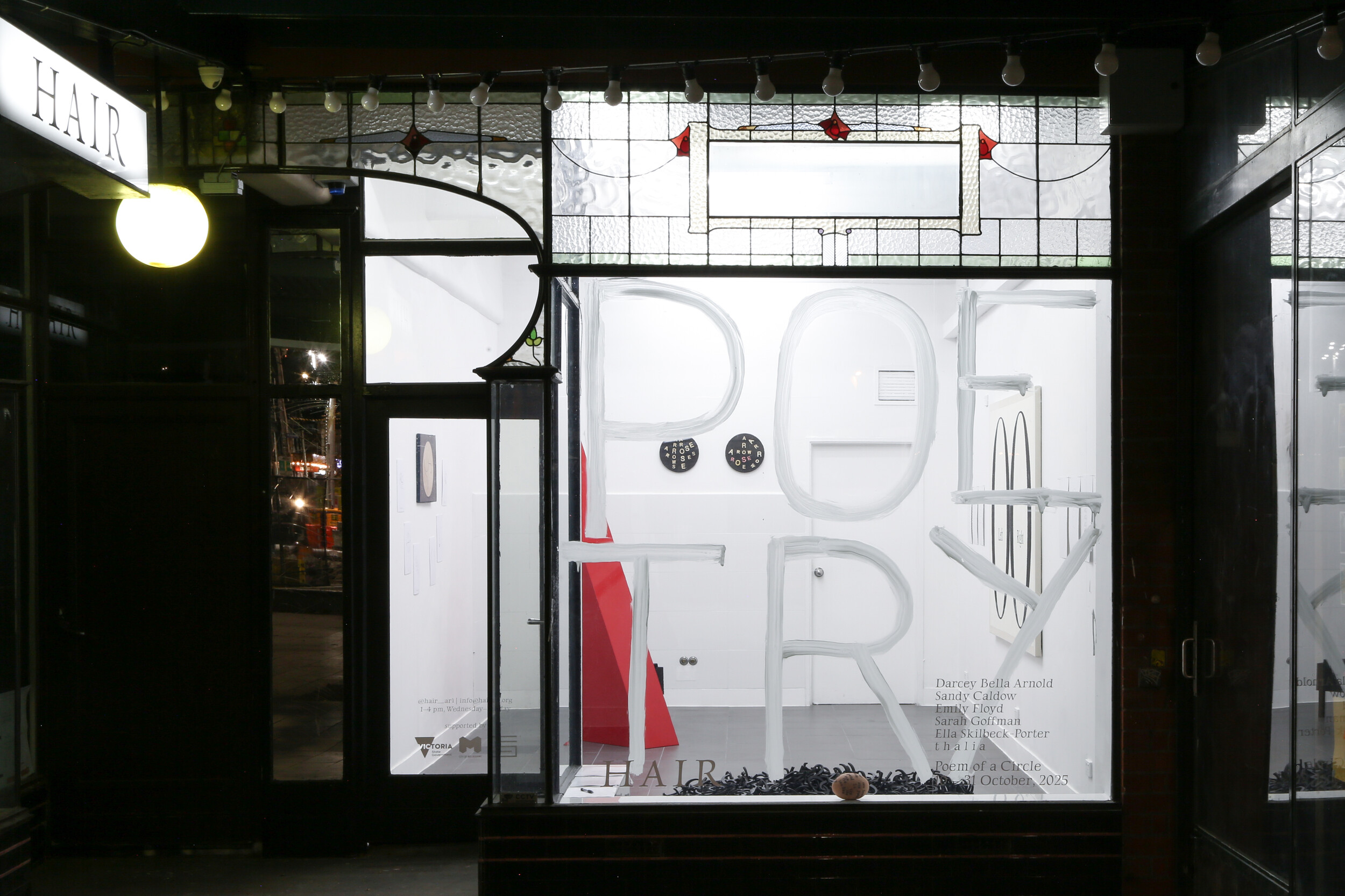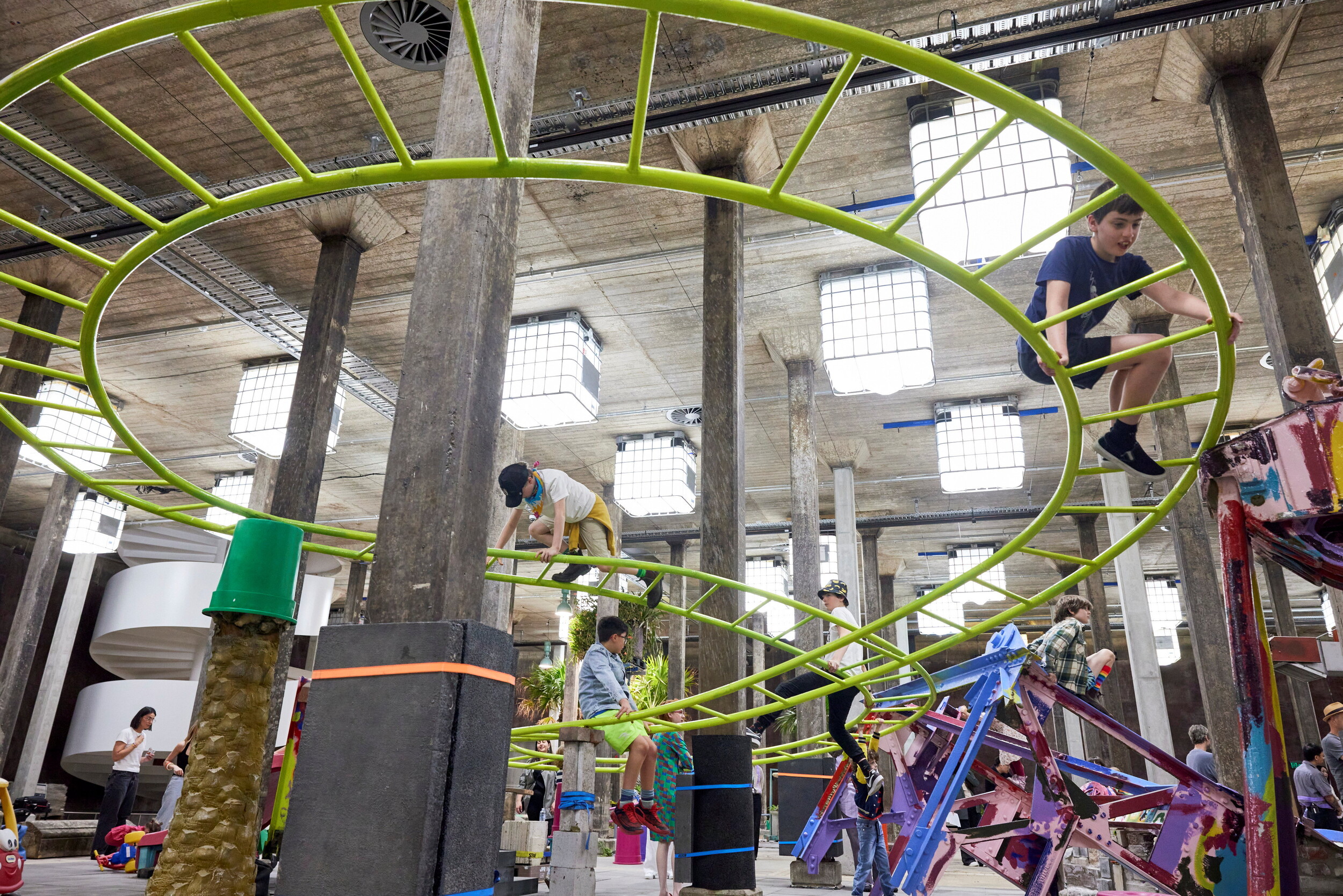Motion Holders; World Mediation; Would You (Rat) Her?
Ella Howells
I’m stitching with every step on the footpath, swinging my arms back and forth in rhythmic motion, headphones clasping my head, emanating a forcefield. The headphones use electromagnets as mediators for energy, a permanent magnetic field that attracts and repulses the electrified diaphragms, creating sound waves. It’s important to have a personal forcefield, some kind of imaginary LARP-esque armour of light conjured to keep your path on course and your arrows straight. I would be curious to see the stat report of how many times I’ve stitched the same places, round and round the city in circular motion. When I was a quirked-up teen, I used to carry a pendulum in my pocket, a pointed synthetic moonstone on a long silver chain, to help me decide which routes to take. I found it again the other day and decided to give it a whirl (literally). In order for it to work, I “program” it to perform a circular clockwise motion for an affirmative position. If it holds still, it’s a no. I hold it in the air and ask it whether it’s a good idea to walk into the city. It whirls in agreement, so I proceed.

I walk to the opening of Gabriella D’Costa’s Motion Holders at Blindside, up on the seventh floor of the Nicholas Building. Here in room fourteen, there are fourteen orbs placed on stainless steel squares on the floor, each with slightly rounded corners. There are another fourteen orbs hanging as pendulums from the ceiling with thin translucent nylon, hovering above a corresponding floor orb. Embedded magnets hold the pendulums, keeping them aligned and binding these lower orbs to the stainless steel beneath. It’s 6 pm and just on the cusp of daylight savings so the jewel-toned resin appears dark and opaque, like miniature bowling balls with a slight effervescence under the fluorescent lights. Some have bubbles, indicating an issue with the resin curing. Gab made them in spherical moulds and dropped pigment into them, working quickly because the resin hardens within one hour. After sanding, their interior is unveiled. Some are striated, some translucent and some luminous. Initially, everyone is timidly milling around the orbs. Someone gasps after I brush past a thread, causing an orb to clunk against its companion. Gab shows me how to pick up the orbs and swing them (with care), either spiralling inwards, drawn back to the centre by their magnets, or back and forth until their magnets arrest their inertia, eventually halting them. Some are weighty and slow; some are compact and zippy.
The show is inspired in part by Edward Leedskalnin (1887–1951), an eccentric Latvian amateur stonemason who emigrated to the United States and built his magnum opus Coral Castle in Florida without any mechanical aid (and, as I learn, on a diet solely consisting of crackers and sardines), using what some say was his ancient esoteric wisdom of magnetic energy to quarry and shift 1100 tons of oolite limestone. His design was centred around numerology and sonic vibrations, with “7129hz” carved into the surface as a reference to the primal force. Small currents of energy in the fingertips surely dictate why pendulums swing enthusiastically at some proposals and remain still at others, and the same energetic principles explain why magnetic fields act the way they do—physics is like legal magic. Perhaps Leedskalnin preceded the current fandom for binaural beats with healing purposes? RIP; he would have loved wireless headphones.
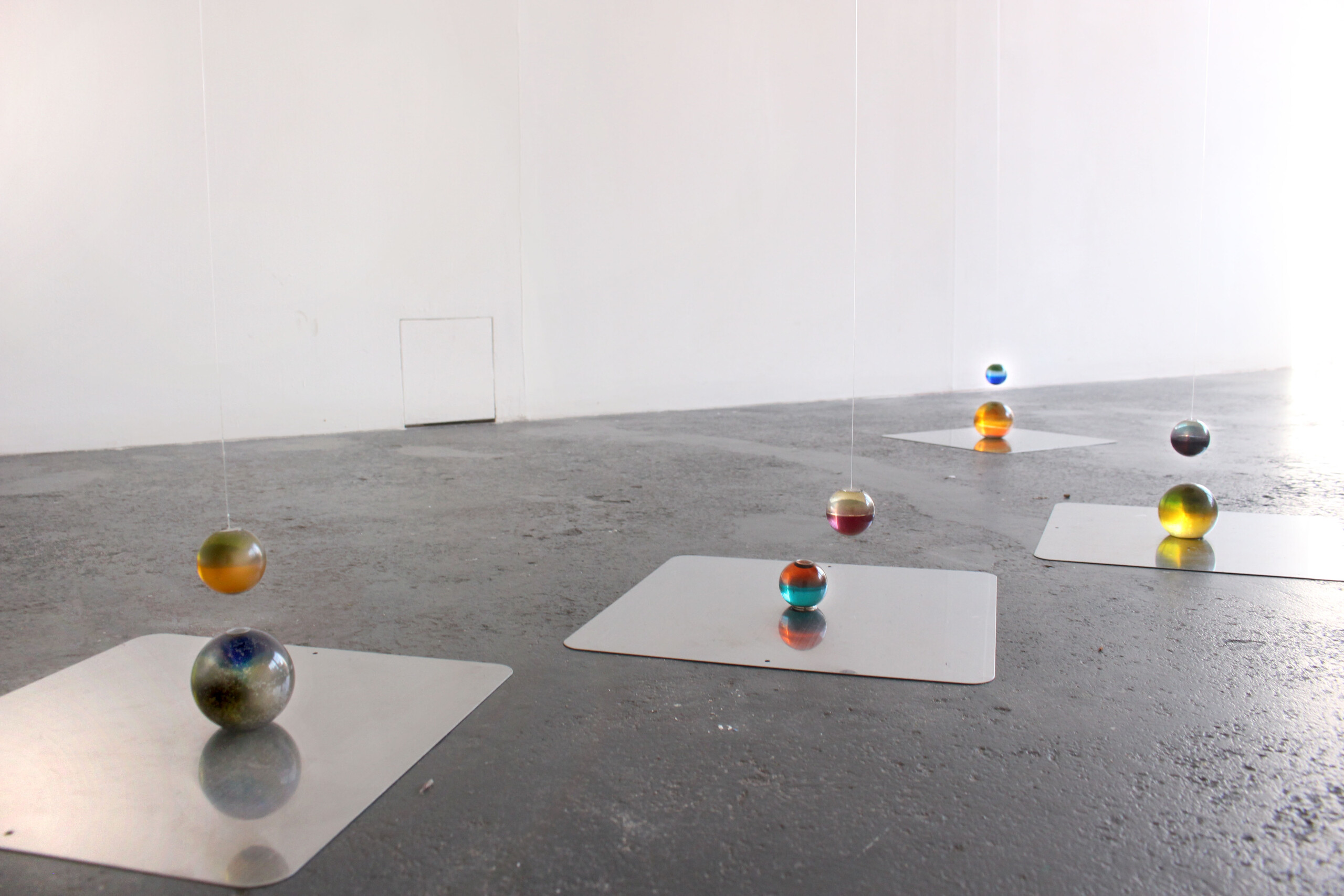
On my second visit to D’Costa’s show (so hungover it feels almost psychedelic, drinking that infamous Best Smoothie In The World With The Secret South American Ingredient), someone takes the liberty of lining up three of the stainless steel squares next to each other whilst sitting cross-legged on the ground, inadvertently reflecting the meditative aura of the droning music echoing in from the other gallery space. He places two orbs beneath one that is hanging, and the latter begins to sketch a jerkily animated figure 8 path as it is propelled and repelled continuously. The next one sketches a four-pointed star shape above its companion, whilst the last one shivers. In his 1945 pamphlet Magnetic Currents, Leedskalnin suggests that magnets, when “guided in the right channels possess perpetual power… the North and South Pole magnets, they are cosmic force, they hold together this earth and everything on it”. Maybe it’s the hangover haze, or the Secret Ingredient, but this feels true—a circle of people form around the orb cluster on the floor. Some kind of communion is happening, with the orbs acting as psychic intermediaries for something invisible.
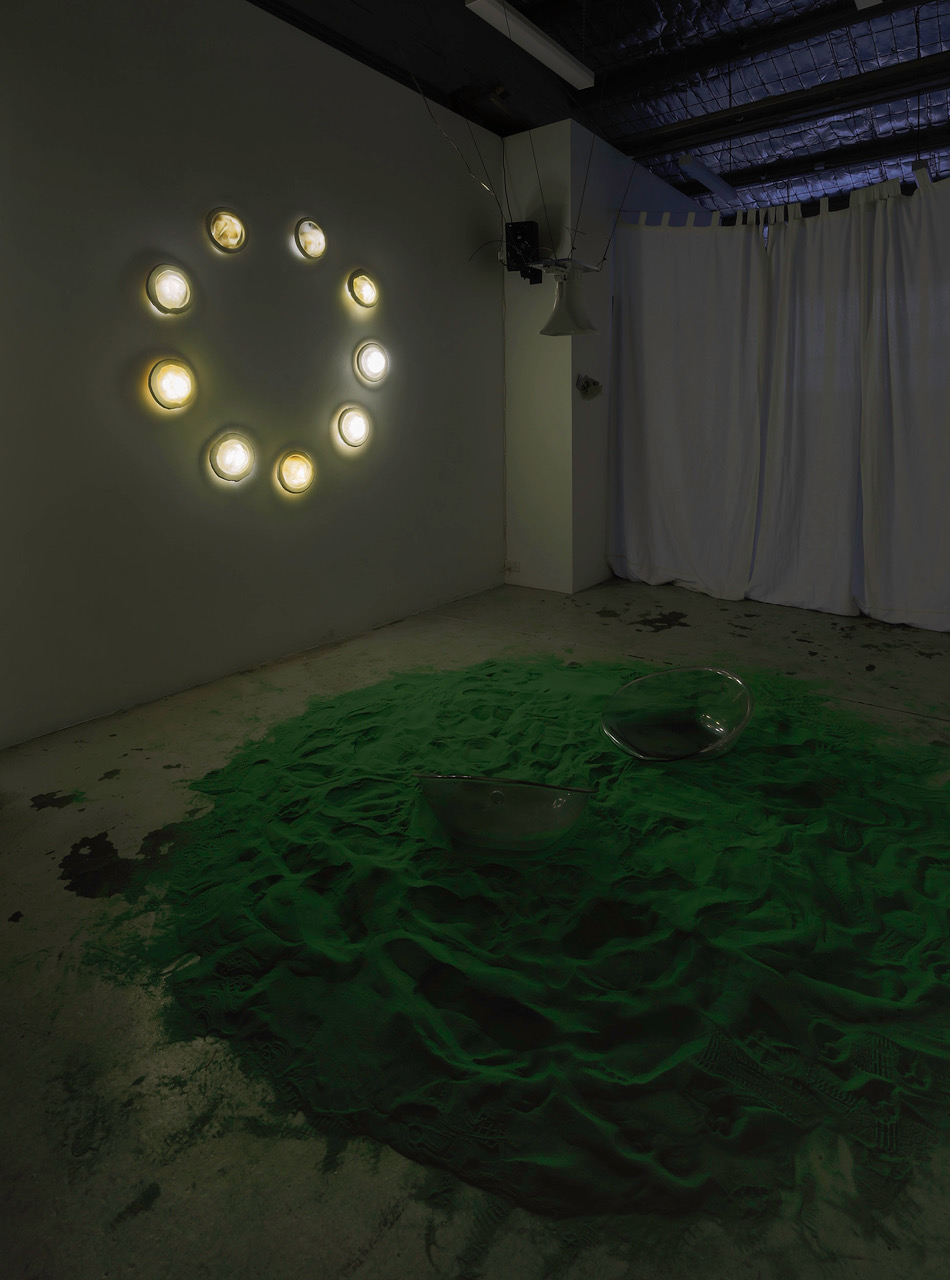
This communally meditative undercurrent carries on at TCB gallery, in Gab Nehrybecki’s show World Mediation. A swelling sound-bath-esque soundtrack wafts out from behind a curtain. Passing through, two clear plastic chairs sans legs sit embedded in a mound of electric-green sand; a verdant sunken lounge. The chairs are pointed at a forty-five-degree angle towards each other, inviting the visitor to stoop and wedge themselves in, whilst a megaphone-style speaker hangs from the ceiling. It’s the source of the chiming music and a soothing, disembodied female voice that begins to murmur. I recline into the sand pile, tingling running up and down my arms as the voice soothes me. I feel like I’m in a psychological massage centre. I suppose this is what ASMR is? (I’m uninitiated, don’t come for me…or maybe do if you have recommendations…)
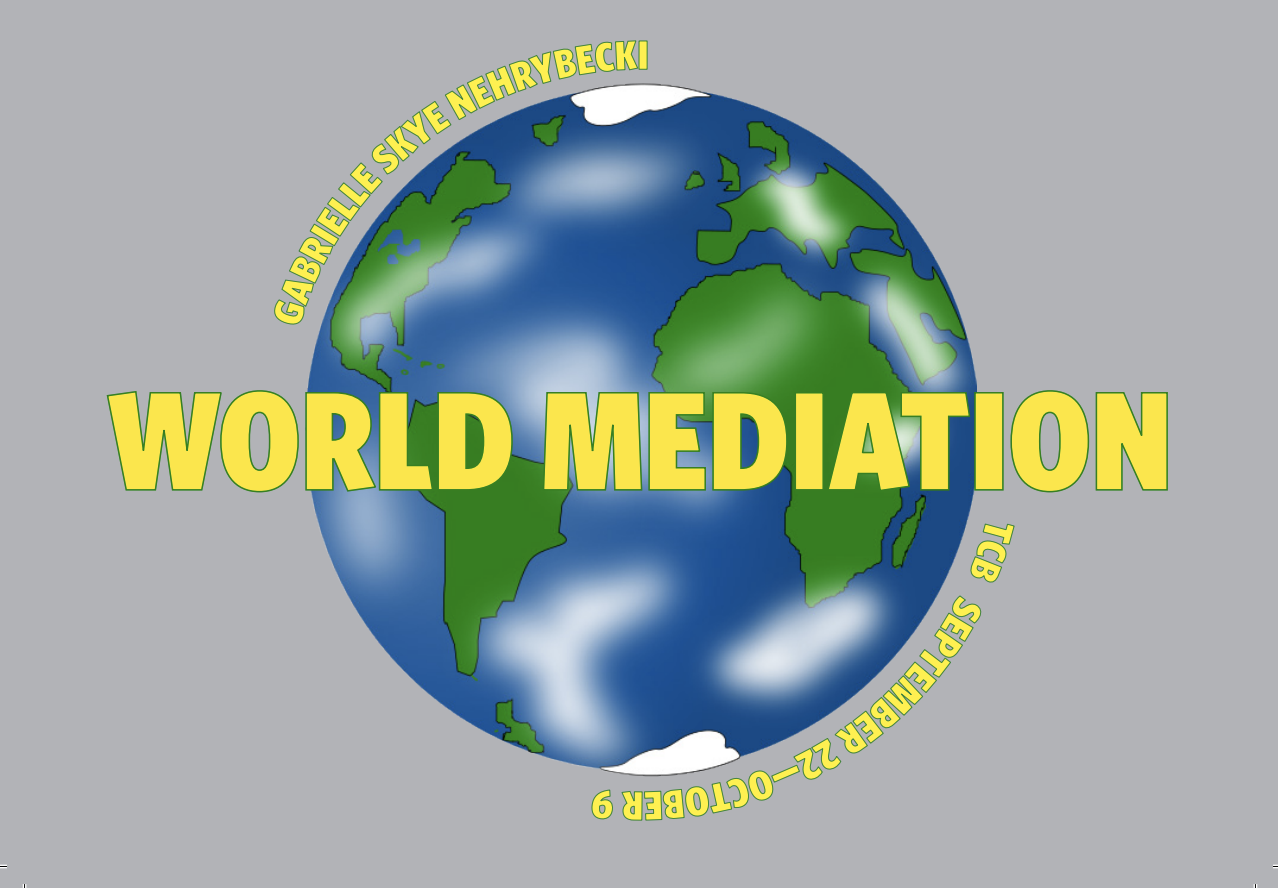
The accompanying text, written by Natasha Havir-Smith, is housed within a concertina-folded pamphlet designed like a new-age guided past-life regression cassette cover insert. The poetry sprawls and repeats in loops like a mantra on the topic of energy, “comparing the nature of a stars cycle to the nature to that of a human’s existence, the cycle of a human and humming”. This holistic circularity between seen and unseen forces commuted by “mediation” is—like D’Costa’s show—represented by the motif of orbs. There’s a subtle glow radiating from a large circular portal composed of many-layered rice-paper portholes that are inlaid into the wall, each with tonalities ranging from grey to pale yellow, which change over time as mould proliferates within. Nehrybecki sends me a picture of the fuzzy speckles in various shades of blue, brown and black, like a spindlybraille message. These orb-lights are positioned like the dial of a luddite telephone that you could spin to converse with another realm. When this call is initiated during a performance by violinist Luyuan Zhang at the show’s finissage event, I observe the metaphorical lamentation of the portal closing through Instagram stories and appreciate the way the green sand clings to the assorted tulle, cotton, rubber and polyester surfaces that come into contact with it, walking it out beyond the walls.
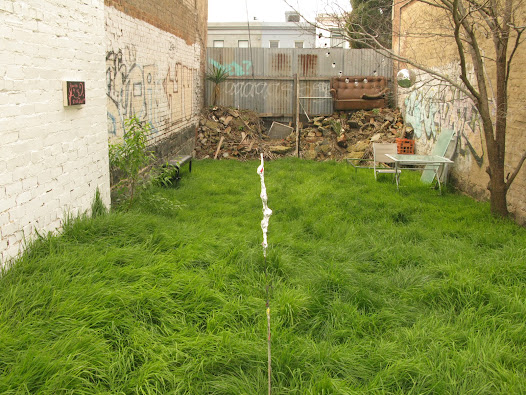
Afterwards, I reengage my headphone forcefield to make my way across town to a homegrown group show called Would You (Rat)Her? at newly minted Carlton garden gallery Priscilla’s. In order to access the gallery, I must take note of the number on the peeling front door of a terrace share house and walk around the corner down an adjacent bluestone alleyway. I then knock on a neighbour’s gate that kindly gives access to a yard on a vacant block (the gallery), which presumably once held a similar terrace house. Its brick remnants have been arranged by artist and Priscilla’s co-curator Rosy Angela Murphy in an archaic-looking R-shaped henge named Raz, partially shrouded in the lush native grass that now rehabilitates the block. This is one of several simple pieces that are understated next to the glut of racy neo-Y2K works that line the graffitied walls, grounding the show through their reference to the ancient.
A tottering cairn of these bricks supports an inaccessible sofa that acts as a plinth for a painting by Amelia Spencer. It’s papier-mâché and grout on MDF board with coloured pencil hatched over it in a pastel-toned grid, a Pinterest Coquette Pastel Eyeshadow Palette with the softness of an Agnes Pelton painting. In front of this, an untitled piece by anarcho maestro Christopher LG Hill is stuck into the soil as an irreverent garden ornament/lightning stick, a bamboo rod clad with a lumpy alfoil sheath evocative of hive-craft by an alien wasp colony. It’s placed centrally in the yard, like a conductor’s wand for the revellers revolving around it.
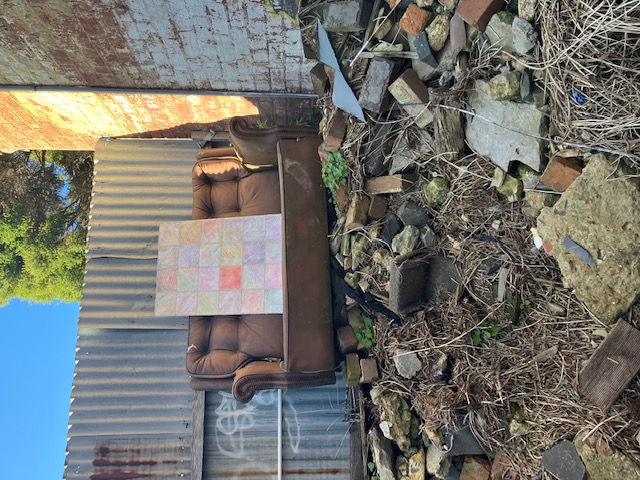
Inverse to this in form and theme, a woven wooden wreath sits quietly on the concrete section next to the beer table, housing a petite clay angel kneeling in prayer. It reminds me a little of the mini tooth fairy doll I would put in a box to guard my freshly lost tooth on my bedside table, whose feet have now snapped but whose halo remains intact. The co-curators Lili and Rosy show me Lili’s blogspot with all the pics. On the blog, this piece is simply the angel and wreath, but in the wreath’s centre Lili has now added a print of a man lifting his shirt to reveal a tattoo in classic script calligraphy above his boxer band that says No Man’s Land. The angel sits facing downward towards it, as if it is reading and contemplating what lies beneath his buckle. I think about that Sheila Heti quote from How Should A Person Be about giving blowjobs in heaven. What goes up, must go down. Circularity.
All three shows ascended a similar energetic spiral, om-ing on the same wavelength. They felt sincere and sequential, like shaking then drinking different cocktails with one spirit tapped from a common well. The same force that propelled me around the city that day was present within the work, light and liquidly. I felt a little tipsy again. The metal, motion, sand, mould, plastic, sound, grout, foil, sticks and bricks built a textural impression of a certain omnipresent, omnipotent devotional grunge that has been budding in urban centres for the past few years before this present springtime emergence. Rock on.
Ella Howells is a writer, artist and arts worker on unceded Wurundjeri land.

